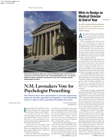Each year approximately 50,000 Americans die violent deaths. To learn more about homicides, suicides, and unintentional gun deaths and ultimately stop them, the Just the Facts Campaign is working to build broad-based support for a National Violent Death Reporting System (NVDRS).
The NVDRS is a new initiative of the Centers for Disease Control and Prevention (CDC) that will provide for the first time a uniform, detailed state-based data system, which is hoped to guide strategies that prevent violent deaths.
A number of health organizations, such as APA, are joining together to request federal support for the project. In December 2001, Congress approved the first funding for the NVDRS—$1.5 million for fiscal year 2002.
Suicide accounts for 30,000 of those deaths, while other deaths result from assaults, child abuse, domestic violence, and youth violence, according to Martha Witwer, M.P.H., M.S.W., executive director of the HELP Network. The network includes more than 120 medical and professional organizations committed to reducing the number of deaths caused by handguns. In addition to APA, HELP’s membership includes the American Academy of Child and Adolescent Psychiatry, the American Medical Association, and the American Academy of Pediatrics.
Current tracking systems lack data on the circumstances leading up to each death and other important details, such as the type of weapon involved in the killing and place of death, according to Witwer.
Another problem is that there is no integrated system to collect information on violent deaths. “Death certificates provide some information on violent deaths, while police, crime labs, and medical examiners collect other information that can fill in the details about such deaths,” Witwer noted.
The goal is for the NVDRS to connect data from these and other systems to get a full picture of each death and the circumstances surrounding it. It doesn’t reinvent the wheel but instead aims to get input from different agencies and to compile the data in a uniform way. The cost of building such a system, which initially may involve up to 20 states, is about $10 million, and the cost for 50 states to maintain the system would be twice that figure each year.
At a meeting in May 2000, representatives from the FBI, the Bureau of Justice Statistics, and the U.S. Surgeon General’s Office agreed that the NVDRS should be coordinated and funded by the federal government and maintained by the CDC. Last year more than 60 organizations from the fields of medicine, public health, child welfare, youth violence, and domestic violence prevention signed letters to members of Congress requesting support for the system.
According to David Fassler, M.D., chair of APA’s Council on Children, Adolescents, and Their Families, the goal of the campaign is to increase awareness and recognition about the problems associated with violence in the United States and work together to develop effective solutions. Fassler is the APA representative to the Just the Facts Campaign and a member of its National Speakers Bureau.
“There is a need to collect strong and accurate data and to think about violence as a public health problem,” said Fassler. He added that health professionals, schools, families, and entire communities can work together to come up with effective solutions.
Stressing the powers of prevention, Fassler said, “Most kids who get involved in serious violence have had signs and symptoms for years. We need to do a better job of getting to them earlier and making sure they get comprehensive evaluations and the appropriate interventions.”
Fassler also said he is concerned about the incidence of suicide in adolescents and, lately, an increase in the number attributable to firearms.
Two smaller-scale tracking systems would serve as models for NVDRS. One is the Fatality Analysis Reporting System (FARS) of the National Highway Traffic Safety Administration, which collects information in all 50 states on fatal automobile accidents. Policymakers have used FARS data to bring about safety interventions such as child-restraint laws and campaigns against drunken driving.
The other is the National Violence Injury Statistics System at the Harvard Injury Control Research Center. The program is now piloting a data collection protocol in which 13 sites across the country collect information on violent deaths and nonfatal injury data. For instance, if a person commits suicide, data on his or her mental health history and prior attempts are collected. Other factors noted are health status, relationship problems, job stresses, and the presence or absence of a suicide note.
U.S. Surgeon General David Satcher, M.D., also called for better data collection on suicides in his National Strategy for Suicide Prevention, released last May (Psychiatric News, June 1, 2001).
The Web site of the Help Network is www.helpnetwork.org, and the Just the Facts Web site is www.jtfcampaign.org. ▪
